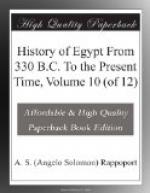Strato, the pupil of Theophrastus, though chiefly known for his writings on physics, was also a writer on many branches of knowledge. He was one of the men of learning who had taken part in the education of Phil-adelphus; and the king showed his gratitude to his teacher by making him a present of eighty talents, or sixty thousand dollars. He was for eighteen years at the head of one of the Alexandrian schools.
Timocharis, the astronomer, made some of his observations at Alexandria in the last reign, and continued them through half of this reign. He began a catalogue of the fixed stars, with their latitudes and their longitudes measured from the equinoctial point; by the help of which Hipparchus, one hundred and fifty years afterwards, made the great discovery that the equinoctial point had moved. He has left an observation of the place of Venus, on the seventeenth day of the month of Mesore, in the thirteenth year of this reign, which by the modern tables of the planets is known to have been on the eighth day of October, B.C. 272; from which we learn that the first year of Philadelphus ended in October, B.C. 284, and the first year of Ptolemy Soter ended in October, B.C. 322; thus fixing the chronology of these reigns with a certainty which leaves nothing to be wished for. Aris-tillus also made some observations of the same kind at Alexandria. Few of them have been handed down to us, but they were made use of by Hipparchus.
Aristarchus, the astronomer of Samos, most likely came to Alexandria in the last reign, as some of his observations were made in the very beginning of the reign of Philadelphus. He is the first astronomer who is known to have taken the true view of the solar system. He said that the sun was the centre round which the earth moved in a circle; and, as if he had foreseen that even in after ages we should hardly be able to measure the distance of the fixed stars, he said that the earth’s yearly path bore no greater proportion to the hollow globe of the heavens in which the stars were set, than the point without size in the centre of a circle does to its circumference. But the work in which he proved these great truths, or perhaps threw out these happy guesses, is lost; and the astronomers who followed him clung to the old belief that the earth was the centre round which the sun moved. The only writings of Aristarchus which now remain are his short work on the distances and magnitude of the sun and moon, in which the error in his results arises from the want of good observations, rather than from any mistake in his mathematical principles.




